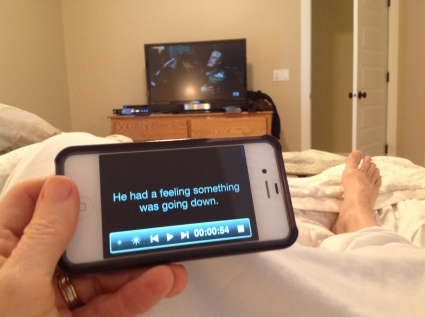On December 14, 2012, deaf twins in Belgium (Marc and Eddy Verbessem) were granted their wish to be euthanized. It was reported that they had fought for the right because they were going blind and were distraught at not being able to see each other ever again (e.g., http://abcnews.go.com/blogs/headlines/2013/01/belgium-euthanizes-deaf-twins-going-blind/, http://www.ibtimes.com/deaf-twins-euthanized-belgian-brothers-marc-eddy-verbessem-wanted-die-because-they-were-going-blind).
They were 45 years old, lived together, worked as cobblers, and used home signs to communicate with each other and their family. From this, I assume they weren’t connected with the Belgian Deaf community (Fevlado). They were born deaf, and a few years ago started losing their vision to a genetic form of glaucoma. It was reported that they would have, within a short time, become completely blind.
They searched for 2 years to find a doctor, and they fought for the legal right to be euthanized. (Belgium law allows physician-assisted suicide, but usually the patients are terminally ill.) Their family was against it, but were finally convinced that this was what they wanted. One of the reports said the twins were concerned about being a burden on their family. They were also worried that they would be institutionalized if their parents died before them.
It is not my place to judge or second guess them. I wouldn’t want anything that I said here to bring any more grief to their family. If they have been fighting for this for a few years, they had time to change their minds, and others could have intervened to show them other options. The one thing that was clear to me in what I read was that their minds were made up. But the rest of the story just didn’t feel right. It is an easy mark for sensationalism because it is controversial. Do you support doctor assisted suicide? Would you support it in the case of terminal illness? What if you had a condition that would make life intolerable?
I know that isolation and loneliness can be intolerable. A friend of mine with genetic hearing loss in her family told me how several members of her extended family had committed suicide over the years when their hearing loss had become severe enough that they were cut off from family and friends. These people weren’t connected with a hearing loss community, weren’t aware of other technology beyond hearing aids, and weren’t connected with anyone who could tell them that there were options for coping. Even though they had jobs, maybe Eddy and Marc didn’t have a community outside of their family. Isolation could have been a very real fear for them.
I don’t know what the services are like in Belgium. For that matter, services in the US for people who are deafblind leave a lot to be desired. Imagine having only an hour a week of a support service provider (SSP) who can help you with shopping and interacting with the world. The truth is there are plenty of deafblind people in the US who would be thrilled to have that much time with an SSP. Many states don’t provide any, and even if they did, there are not always enough trained people who can provide the service. If Eddy and Marc were using home signs, that would have made it more of a challenge to find SSPs who could work with them.
I also know families who are worried about what will happen to their adult son or daughter with a developmental disability when the aging parents who are supporting them are no longer able to care for them. I’m not making light of their concerns. Eddy and Marc’s reported concerns could be very real.
The thing is, there just had to be more to the story. I couldn’t imagine that two people who were creative enough to develop their own language between them couldn’t imagine other solutions for themselves. After doing quite a bit of searching I finally found out the brothers also had other serious physical issues they were dealing with (http://deafcapital.blog.com/2013/01/16/the-belgian-twins-euthanasia-and-the-myth/). One had spinal damage so severe that getting around was difficult for him, and the other had to sleep sitting up because of respiratory problems. One had just had surgery on his heart. There were limited medications they could take because of the glaucoma.
That’s the sticking point. They did not wish to die just because they were going blind. They were dealing with multiple health issues. The media reports I found took it for granted that it is reasonable for anyone who is deaf and blind to wish for death. The subtext is that such a life would not be worth living. If Belgian law stated that anyone who wished to die for whatever reason could seek out physician-assisted suicide, that would be one thing. But the media reports wrongly stated that the twins were able to convince a doctor to euthanize them because they were going blind and that being blind in addition to being deaf was intolerable to them. This is not what happened. The media either wanted this to be the story, or thought that was the story the public wanted.
The media is playing a dangerous game when they take such liberties. If you are posing the question of the acceptability of euthanasia in the case of an intolerable condition, the real question is, “Intolerable according to whom?” What if you have a condition that would make life intolerable in the eyes of others? How marginalized would you feel if, because of the tone of these stories, people were now looking at you as if your life were intolerable? At some point, will it justify others making euthanization decisions for you? Which is worse: euthanization or simply being locked away? What about sterilization? The days when this was true are not that long ago (and I’m sure are still true in many places. There are many stories of children with disabilities being kept locked up.). I am not against doctor-assisted suicide, as long as it provided after a well informed decision by the individual. The problem for people with hearing loss is that there is a history of bias in what information is given to them and their families. The media is perpetuating myths and stereotypes about life with disabilities. It can and does result in policy driven by misinformed public opinion that affects millions.
January 22 Update:
The National Association of the Deaf (NAD) and the American Association of the Deaf-Blind (AADB) have issued a press release to respond to the media bias in the reporting on Belgium’s Euthanasia of Deaf-Blind Twins: http://www.nad.org/http%3A/%252Fnad.org/news/2013/01/beglian-twins-deaf-blind.
Photo credit: http://www.telegraph.co.uk/news/worldnews/europe/belgium/9800378/Belgian-twins-had-first-request-to-die-refused.html




 Posted by cherylddavis
Posted by cherylddavis 







